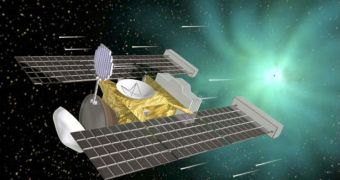The current NASA Stardust probe is a mission aimed at flying thorough the tail of a comet, collecting dust samples, and returning these samples back to Earth. It builds on a previous Stardust mission, which was launched in 1999 and returned home in 2006. The new mission took off in 2007, and is scheduled to meet up with its target, the Temple 1 comet, in about a year. Two days ago, the spacecraft performed a series of engine firings, which allowed it to adjust the exact time of its flyby by about eight hours and 20 minutes. This will in turn enable it to make the most of its flight, PhysOrg reports.
Temple 1 is a potato-shaped comet, about 3-kilometer (1,86-mile) wide. It is made entirely of dust and ice, and NASA mission planners also want to capture high-resolution of its surface, in addition to actually flying through its debris field. The delay that was now inserted in the mission was performed precisely to allow for the clearest images possible to be captured by the scientific cameras aboard the spacecraft. Stardust is at this point located on the other side of the solar system, at a distance that theoretically puts it beyond the orbit of Mars. The correction maneuver began at 5:21 pm EST (22:21 GMT), on February 17, and lasted for about 22 minutes and 53 seconds.
With the new data, it is estimated that the spacecraft will rendezvous with the comet on Valentine's Day 2011, at around 11:41 pm EST (0400 GMT, February 15). Knowing precisely when the probe will pass the comet by is important as this will allow NASA experts to estimate which of the regions on the comet will be facing the Sun at the time, allowing for interesting photos to be collected. The team managing the mission is especially interested in following up on observations conducted in 2005, using the space agency's Deep Impact probe.
“We could not have asked for a better result from a burn with even a brand-new spacecraft. This bird has already logged one comet flyby, one Earth return of the first samples ever collected from deep space, over 4,000 days of flight and approximately 5.4 billion kilometers (3.4 billion miles) since launch,” says Stardust-NExT project manager Tim Larson, who is based at the NASA Jet Propulsion Laboratory (JPL), in Pasadena, California.
“Stardust-NExT will provide scientists the first opportunity to see the surface changes on a comet between successive visits into the inner solar system. We have theories galore on how each close pass to the sun causes changes to a comet. Stardust-NExT should give some teeth to some of these theories, and take a bite out of others,” says the mission's principal investigator, Joe Veverka, who is based at the Cornell University, Ithaca, New York.

 14 DAY TRIAL //
14 DAY TRIAL //